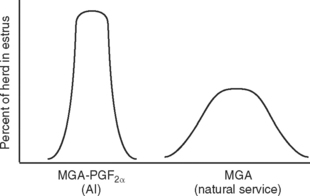CHAPTER 37 Progestogen-Based Estrus Synchronization for Beef Replacement Heifers and Cows
The beef cattle industry has seen rapid gains in economically desirable traits, largely as a result of the selection and expanded use of genetically superior sires made available through artificial insemination (AI). Recent surveys indicate, however, that less than 5% of the beef cows in the United States are bred by AI, and only half of the cattle producers who practice AI use any form of estrus synchronization to facilitate their AI programs. The inability to predict time of estrus for individual cows or heifers in a group often makes it impractical to use AI because of the labor required for detection of estrus. Available procedures to control the estrous cycle of the cow can improve reproductive rates and facilitate genetic progress. These procedures include synchronization of estrus in cycling females and induction of estrus accompanied by ovulation in heifers that have not yet reached puberty or among cows that have not returned to estrus after calving.
The following protocols and terms are referred to throughout this chapter.
To maximize the benefits from estrus synchronization, females should be selected for a program when the following conditions are met1:
DEVELOPMENT OF METHODS TO SYNCHRONIZE ESTRUS
A single injection of GnRH to cows at random stages of their estrous cycles causes release of luteinizing hormone leading to synchronized ovulation or luteinization of most large dominant follicles. Consequently, a new follicular wave is initiated in all cows within 2 to 3 days after GnRH administration. Luteal tissue that forms after GnRH administration is capable of undergoing PGF2α-induced luteolysis 6 or 7 days later.2 This method is referred to as the GnRH-PGF2α protocol throughout this chapter. The GnRH-PGF2α protocol increased estrus synchronization rate in both beef3,4 and dairy5 cattle. A drawback of this method is that approximately 5% to 15% of the cows are detected in estrus on or before the day of PGF2α injection, so that a smaller proportion of females are detected in estrus and inseminated during the synchronized period.6
THE MELENGESTROL ACETATE PROGRAM
MGA may be fed with a grain or a protein carrier and either top-dressed onto other feed or batch-mixed with larger quantities of feed. MGA is fed at a rate of 0.5 mg/animal/day in one feeding. The duration of feeding may vary between protocols, but the level of feeding is consistent and critical to success. Animals that fail to consume the required amount of MGA on a daily basis may prematurely return to estrus during the feeding period. This can be expected to reduce the synchronization response. Therefore, adequate bunk space must be available so that all animals consume feed simultaneously.
Method 1: MGA with Natural Service
The simplest MGA-based method of estrus synchronization involves using bulls to breed synchronized groups of females. This practice is especially useful in helping producers make a transition from natural service to AI. In this process, cows or heifers receive the normal 14-day feeding period of MGA and are then exposed to fertile bulls about 10 days after MGA withdrawal (Fig. 37-1).
Method 2: MGA plus Prostaglandin
In this program, PGF2α should be administered 19 days after the last day of MGA feeding. This treatment places all animals in the late luteal stage of the estrous cycle at the time of injection, which shortens the synchronized period and maximizes conception rate (Fig. 37-2). Although a 19-day interval is optimal, 17- to 19-day intervals produce acceptable results and provide flexibility for extenuating circumstances.7,8 Any of the four available PGF2α products can be used for synchronization of estrus in cattle after the MGA treatment. Label-approved dosages differ with each of these products; the practitioner should carefully read and follow directions for proper administration before their use.
Figure 37-3 illustrates the distribution of estrus comparing the MGA-PGF2α system and an MGA-only system.9 The combined MGA-PGF2α system is best suited for use with AI programs because of the high degree of synchrony that can be achieved, which decreases the amount of time required for detection of estrus. Under natural mating conditions, distributing estrus over several additional days may be advantageous, to prevent overworking of bulls used in these programs.
Stay updated, free articles. Join our Telegram channel

Full access? Get Clinical Tree





